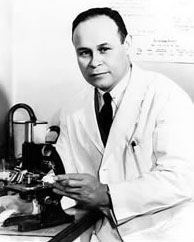Jim Crow Museum
1010 Campus Drive
Big Rapids, MI 49307
[email protected]
(231) 591-5873
All my life I have been taught that Charles Drew, the creator of the blood bank, died because White doctors refused to give him a blood transfusion. If that was true it would be a terrible irony. What can you tell me about his death?
-- Mason Boyd, Greensboro, North Carolina

That story is not true.
Charles R. Drew was a teacher, physician and medical researcher. In the latter role, his accomplishments were nothing short of brilliant. Awarded a Rockefeller Fellowship in surgery in 1938 at Columbia University, Drew wrote a doctoral thesis entitled, "Banked Blood." In his research he discovered that by separating plasma (the liquid part of blood) from the whole blood (where the red blood cells exist) and then refrigerating them separately, blood lasted longer and was less likely to become contaminated. Drew also demonstrated that everyone has the same type of plasma; thus, in those instances where a whole blood transfusion is unnecessary, a plasma transfusion could be administered, regardless of blood type. He helped establish a blood bank at Columbia University and became the first African American to receive a Doctor of Medical Science degree from that university.
During World War II, Drew was appointed Supervisor of the Blood Transfusion Association for New York City and oversaw the "Blood for Britain" program, which saved the lives of many wounded soldiers. This success led to his appointment as Director of the Red Cross Blood Bank and Assistant Director of the National Research Council, responsible for blood collection for the United States Navy and Army. He resigned in protest of the United States War Department's policy that African American blood should be separated from the blood of White Americans.
Drew eventually became Chief of Staff and Medical Director of Freedman's Hospital and Head of Surgery at Howard University, where he was an influential teacher and a role model to students interested in medicine.
On April 1, 1950, Drew was traveling to the Andrew Memorial Clinic in Tuskegee, Alabama to deliver a lecture. He was accompanied by three of his resident physicians from Howard University. All four passengers were Black. Drew apparently fell asleep while driving. The car ran off the road (N.C.49 near Haw River), and rolled over. He was thrown out of the car and the vehicle rolled over him. Drew suffered a nearly severed leg, massive chest injuries, a broken neck, brain damage, and complete blockage of the blood flow to his heart. Only one other person was seriously injured, John Ford, but he eventually recovered.
Drew and Ford were taken to Alamance General Hospital, a facilities-poor "White" hospital. The White doctors at Alamance began work immediately on the two injured men. Drew's injuries were so severe and his loss of blood so great that he could not be saved. His family later wrote letters to the attending physicians thanking them for their efforts. Ford was treated at Alamance for several days before being transported to Washington, a Black hospital.
Almost immediately rumors spread that Dr. Charles R. Drew, the internationally famous inventor of the blood bank, had died because a White hospital refused to give him a blood transfusion. To many African Americans the story was believable. In 1950 the South was still rigidly segregated, and Black Americans were often denied treatment in hospitals -- sometimes because the hospitals did not have vacant "Negro beds," and sometimes because the hospitals were for Whites only. Drew received emergency medical attention, but many Black Americans did not.
Please read, One Blood: The Death and Resurrection of Charles R. Drew, written by Spencie Love (The University of North Carolina Press, 1997). This book is an examination of Drew's life and the controversy surrounding his death.
June 2004 response by
David Pilgrim
Curator
Jim Crow Museum